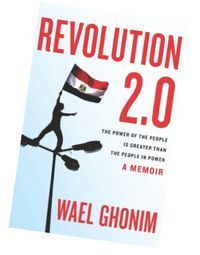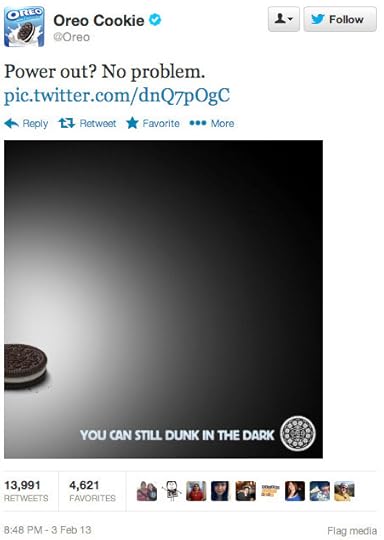David Meerman Scott's Blog, page 77
February 12, 2013
Content marketing and video showcase expertise and drive tons of business
 You could hardly ask for a more dramatic example of how near zero-cost videos can expand reach and drive business. And it all started because Mary McNeight identified a problem that no one online was helping people solve.
You could hardly ask for a more dramatic example of how near zero-cost videos can expand reach and drive business. And it all started because Mary McNeight identified a problem that no one online was helping people solve.
When Mary couldn't find anyone in the Seattle area who would help her train her own dog Jasper for service work, it fell to her to teach her pet to be her service dog. Service dogs that help people manage disabilities like blindness and diseases like recurrent seizures and diabetes.
Later, she enrolled in puppy classes to train Liame, her new Labrador retriever puppy. In the process, she became addicted to dog training—so she made it her business.
Mary spent countless hours learning all aspects of the business, got her accreditation from the Certification Council for Professional Dog Trainers, and is now owner and director of training and behavior at Service Dog Academy. This business offers private training sessions and small-group adult-and-puppy training classes for both service and pet dog training. They even offer a groundbreaking train your own Diabetic Alert Dog program.
Content marketing and video production
But credentials, skills, and even passion alone don't bring in customers. Her excellent website (featuring dozens of videos that she shot and edited herself) educates buyers and generates high search-engine rankings, driving business her way.
"I've gone from barely having any students to getting anywhere from twenty to forty emails per day requesting my services and advice and verbally praising my work," Mary says. "If that isn't a story of success, I don’t know what is. I have the power to create an audience for any product or service I put my mind to. But I think I will stick with what makes me happiest, helping dogs and the disabled live more productive lives."
In 2010, Mary started making YouTube videos with an inexpensive Flip Video camera and the software that came installed on her Mac notebook computer. "Seeing a need for my students to understand how to make a Kongsicle, I produced my first instructional video," Mary says. Kongs are natural rubber-food puzzle toys for dogs, and a Kongsicle is a Kong with frozen food inside. The video is titled Best Dog Food Puzzle: The Kongsicle.
"A couple of months later, I went to the Association of Pet Dog Trainers conference, and I was startled by a young trainer who said, 'You're Mary McNeight right? You made that video on Kongsicles! I use it as a reference video for my students.' Here was this dog trainer in Florida using my materials for her classes. That was the day I understood the power of YouTube." Since then, Mary has made many instructional videos, with titles that include “Diabetic Alert Dog Scams,” Puppy Doggie Ants in the Pants, and a multi-part series on diabetic alert dog training.
The content on the Service Dog Academy site, including the video series, is created for three buyer personas: pet dog owners, service dog owners, and people who want to train their own diabetic alert dog. After her initial success, Mary purchased a $400 HD video camera, a $20 microphone, Final Cut Pro software, and, as she describes it, "some funky alien-adjustable-arm-looking lights at Home Depot, since I couldn't afford to light my videos with professional lights. The really cool thing about my content is that it proves that it doesn't have to be shiny, flashy, spiffy or cost thousands of dollars to produce. People will watch anything as long as its packed full of useful information."
Make it free
Mary's notoriety and search engine results are aided by her willingness to post content that others in the dog training business are fearful to post because they don't want to give away information for free. "A great success was a video on how to travel with your service dog, something nobody on the entire Internet was teaching people how to do," she says. "I also hosted a webinar that gave an overview of how to train a diabetic alert dog. I placed the webinar capture video on YouTube and was afraid of being banned in the dog training community. This information was not available on the Web because nobody wanted to share how they trained dogs for tens of thousands of dollars. I started getting emails and phone calls from people all over the world asking me for advice on training their dog or just outright purchasing my online diabetic alert dog training program. I’ve had dog trainers who want me to fly out to their location and teach a class on diabetic alert dog training for them.
"How cool is it that this now three-person service dog training organization is getting worldwide attention? I never would have gotten that type of exposure printing brochures or running expensive ads on local television. A couple of months ago, I even had a woman tell me the video I made saved her life! It allowed her to get enough information to help her train her own medical alert dog by herself."
Yes, Mary, it's cool. Keep up the great work and thanks for sharing your story.
February 8, 2013
A company or a guru?
As organizations need special skills and expertise from time to time, many hire a consultant on a contract basis, realizing it is more cost effective than hiring full-time staff.
Meanwhile, many people with specialized expertise choose to go independent, leaving the corporate world to run their own businesses, contract out their skills, or consult based on their expertise. I've been at it myself for more than a decade.
As I was speaking with my friend Steve Johnson about his recent foray into the world of independence, we discussed the fundamental choice that all independents must make: Are you a company or a guru? Either approach can succeed. However, we both noticed that people who don’t make the choice are positioning themselves somewhere in the middle of company and guru and they generally struggle.
Are you a company or a guru?
If you market as a company, build your business around an idea.
Although they can be a one-person company, those who go the company route typically have plans to grow their business with more and more consultants in the future as demand increases.
The marketing of this approach is to make you the CEO of a company—with the emphasis on "company." A great example is Greg Alexander, CEO of Sales Benchmark Index, who has built a very successful professional services firm focused exclusively on sales force effectiveness. While there is information about Greg on his site, the approach Greg took was to build a company.
When you go this route, write using "we" and "our" and design a site to showcase an organization, not a person. You build around a core offering and use a corporate logo.
If you market as a guru, build your business around your expertise.
Although it can be a large organization, the focus of a guru is on one person and his or her vast knowledge with everything else supporting that person.
Typically, people who write books and speak take this approach. Trevor Young is a great example of someone who has turned himself into a guru over the years he has been independent. He calls himself a “PR Warrior on the frontline of the communications revolution.” Everything on his site is about Trevor, written in his own voice and it is very clear that he is a go-to expert.
The marketing for a guru is typically in first person, with "I" and "my" used a lot. You build around your expertise and use a photo.
You can’t be both a guru and a company
Many people try to be both. They talk about "our company" on one page, and "my work" on another confusing the marketplace.
If you're newly independent, you've got a choice to make: Are you a guru or are you a company? It is a very important decision.
When I first spoke with Steve about this a few months ago, he was signaling the market that he was both a guru and a company and as such he was neither. But it was obvious to me that Steve is a guru, because the market knows him as the tech industry’s authority on product marketing and product management processes.
"I'm sure every marketer goes through this," Steve says. "Are we promoting a company, a portfolio, a product, or a service? Most of us can only afford to do one. Once I really listened to my customers, I heard loud and clear that they wanted my expertise, not my models."
One tip to keep it straight in your head: use a [company] logo on every page to remind yourself to speak in "we" terms; use a [person's] photo to remind you to speak in "I" terms.
"I hadn’t really seen the company / guru dichotomy until David pointed it out," Steve says. "And then it became obvious."
I'm glad to see that Steve has since updated his site. Now he uses the first person and his photo is on every page. He's recently written a free ebook (no registration) called Product Management Expertise: beyond the tactical role. The ebook explores expertise needed in product management including domain, market, product, and business and includes ideas for organizing a product management team.
February 4, 2013
Oreo wins the Super Bowl Newsjacking game
At the Super Bowl last night, the power at the New Orleans Superdome went out for 35 minutes. It took just seconds for people to start talking about #BlackoutBowl and less than five minutes for brands to start Newsjacking the story.
Oreo wins big
By far, the best of the lot was Oreo with their real-time ad posted on Twitter. Thanks to my friends who know how much I love this stuff and tweeted me about this. Benjamin Strong was first to alert me (dare I say Benjamin newsjacked the Oreo newsjack...). Others who alerted me include (not in order) Amy Baylee, Melissa Mines, Margaret Ebeling, Dan Moyle, Alan Belniak, Damien Basile, Mike Hapner, and Victor Ruiz. Thank you all.
This morning, there are a bunch of posts and articles talking about #Newsjacking the #BlackoutBowl. At CNN Chelsea J. Carter says #BlackoutBowl generates social media moment for jokesters, advertisers and Matt McGee writes in Marketing Land Oreo, Audi & Walgreens Newsjack Super Bowl Blackout Bowl.
Clearly, getting out quickly is key in such a situation. But as Benjamin said regarding a good effort that not many people saw from home improvement company Lowes, brands really need to put hashtags into their Tweets so people can find them. This real-time tweet "Hey dome operators at the 'Big Game', there are a few Lowe's nearby if you need some generators" was good, but only had a few hundred RTs because few people saw it.
Newsjacking works.
This newsjack from Oreo succeeds because it was fast, its witty and fun, its non-controversial, and it ties back to the brand and its messages.
Newsjacking gets attention. Oreo spent many millions of dollars running television ads during the Super Bowl. But on a cost per view basis, newsjacking generated a much, much bigger ROI.
January 28, 2013
How to use the new Vine social app for marketing and PR
Vine is the newest and hottest social media application available for the iPhone. It was launched late last week by to deliver 6-second videos.
I tell people it's sort of like Twitter for video. And since it was released by Twitter, the integration with Twitter is seamless.
I used Vine to show some covers of the 25 different languages that my book The New Rules of Marketing & PR has been translated into.
I used #vine to show a few of the 26 language covers of New Rules of Marketing & PR. vine.co/v/b5LhgtgpmOP
— David Meerman Scott (@dmscott) January 26, 2013
Like any social network, early adopters like me are trying to figure it out. I've seen my friends Chris Brogan and Steve Garfield playing around with it (check their Twitter feeds for examples) and it's getting a bunch of buzz.
It's really simple to use, you just hold down the iPhone screen to record and lift up to stop. Then you can alter the scene and do it again. This means you can easily do short segments of any length as long as they add up to 6 seconds total. At the end of the video, it repeats into an endless loop and you add a caption and release it to your Twitter feed.
It's very early days, but people seem to be gravitating to using it for demonstrations of something or to capture the feeling in a location. There also seems to be a bunch of people using Vine for porn, but I'm not going to elaborate on that… (Google it).
I'm excited to use Vine to share short snippets of rock shows and I'll try to shoot one at The Vaccines show in Boston tomorrow night.
With just 6 seconds, the challenge for marketing and PR use is to tell a story. In a weird way, I found the 6-second constraint to be very liberating, much like the 140 character limit of a tweet.
To get your creative mind working, here are just a few ideas for how you might use Vine for marketing and public relations purposes. If you have any more, please add as a comment to this post:
A brief product demonstration.
A short statement by the CEO.
Highlights of an art exhibition.
A speaker shows their view of the audience (I'll be doing that!).
Speakers' bureaus, modeling agencies, and actors' reps show clients in action.
Restaurants make visual online menus.
A bartender shows her signature drink being made.
Any kind of "before and after" such as redecorating a room or washing a car.
Walk through of a hotel suite.
Here's a six second "behind the scenes tour" from the MSNBC television network.
#msnbc behind the scenes caught on @vineapp: RT @caramaresca: All in a day's work @msnbc vine.co/v/b5dI1ZbJOdg
— msnbc (@msnbc) January 24, 2013
Let us know how you are using Vine.
January 25, 2013
Hire Philippe Dubost because he has he coolest online CV ever created
My friend Mark Copeman points us to the CV (resume) of Philippe Dubost. He created it in the style of an Amazon page! This is awesome personal branding.
I noticed he's updating it in real-time which is awesome. This is just so clever. (Have I gushed enough yet?)
Obviously, it shows that if you were to hire Philippe, then you'd be hiring his creativity. I call this idea of using web content to get others to tell your stories and share your ideas a World Wide Rave and my book with that title is completely free as a PDF (with no registration required) and on Kindle, iPad, Nook, and Kobo ebook readers.
In a tough job market, showing your stuff online works. That's why Lindsey Kirchoff has a great job at HubSpot even when many of her newly graduated peers are still looking for work.
January 22, 2013
American Airlines announces new branding to its best customers first
Several very positive marketing and product related experiences with American Airlines suggest to me that the company is making great progress since the parent company - AMR Corporation - filed for Chapter 11 bankruptcy protection on November 29, 2011.
Telling your best customers first
 Late last week I received an email from American Airlines with the subject line "Be The First To See Our New Look". The email said that they want their most loyal customers to be the first to see their new logo and the refreshed exterior of new planes. (I am a top elite-level frequent flyer and have more than 1.5 million air miles with American). The email said that in about two hours a new look would be revealed and it teased with a hashtag #newAmerican. Then, a few hours later, another email arrived with the new branding revealed together with a link to a video Becoming a new American.
Late last week I received an email from American Airlines with the subject line "Be The First To See Our New Look". The email said that they want their most loyal customers to be the first to see their new logo and the refreshed exterior of new planes. (I am a top elite-level frequent flyer and have more than 1.5 million air miles with American). The email said that in about two hours a new look would be revealed and it teased with a hashtag #newAmerican. Then, a few hours later, another email arrived with the new branding revealed together with a link to a video Becoming a new American.
I really liked this approach of letting their best customers in on the big reveal. Most large companies would announce such a change to the media first and let the new branding trickle down to customers that way. This is very smart marketing and customer service. The addition of the #newAmerican hashtag indicated to me that American is integrating with social media. Well done.
That particular day, I needed to research an upcoming trip and I noticed the AA.com website had been completely changed over to the new look. Also that day iTunes updated my American app with the new branding. Obviously, the team at American had thought through the rollout and had it timed perfectly (at least the parts that I experienced).
American was established in 1934 and the logo and branding had most recently changed in 1968, so it was a big deal to make this switch.
Improving the customer experience
 On a recent Europe trip on American Airlines, I was intrigued by the gadget being used by Frank Eschmann, who called it his "Flight Attendant Customer Experience Tablet". Turns out Frank was beta testing it and was happy to explain to me how it works.
On a recent Europe trip on American Airlines, I was intrigued by the gadget being used by Frank Eschmann, who called it his "Flight Attendant Customer Experience Tablet". Turns out Frank was beta testing it and was happy to explain to me how it works.
The tablet provides details on who is in what seat and includes their frequent flyer status, so Frank instantly knew that I was among American's best customers. Passengers' onward connections are listed so when there is a delay, the flight attendants know who might need extra attention to make tight connections or rebooking.
Flight attendants also use the tablet to record passenger meal selection, which pops up as a color code while the system simultaneously records how many of each meal remains available during ordering. The in-flight announcement scripts are in the tablet as are the entire safety manual for the plane. Each of these features make it easier for flight attendants to provide good service to passengers.
The gadget is delivered via Android on a Samsung Galaxy Note with AT&T running the data and Frank said that there's email and Web interfaces so he uses it in the airports too. The gadgets are still being tested but will roll out later this year.
As a passenger, I think the availability of the tablets will benefit me. Frank says he loves using it, so anytime my flight attendant is happy, I'm happy. And the more they know about me, the better.
American Airlines and the future
While new branding and product improvements like a gadget for flight attendants are relatively minor when it comes to the complexity of an airline, these several positive experiences suggest to me that American has a bright future as they emerge from their recent troubles.
January 17, 2013
Social media drove the Egyptian revolution but can it bring back the tourists?
This week I delivered a full-day Digital Marketing Masterclass for 250 people in Cairo organized by my friends at Digital Marketing Arts.
I was particularly excited to visit Egypt to speak with people about the role of Facebook and Twitter in the Revolution the culminated on January 25, 2011. On the plane over, I read Wael Ghonim’s @Ghonim excellent memoir Revolution 2.0: The power of the people is greater than the people in power (more on the book below).
Social media drove the Egyptian revolution but can it bring back the tourists?
I arrived wondering if social media was used more in business in Egypt in other places now that the power of these tools was obvious to all. But I learned an important fact as I was talking to people about social media. Many people I spoke with told me how the country is suffering because tourists are scared to come because of what they read and see in the media. People think Egypt is dangerous for foreigners. Tourism is a very important industry in Egypt and a critical source of foreign currency investment and the numbers of visitors is way down.
So at my Masterclass, I asked why not use social media to get the word out that Egypt is open for business and now is a great time to visit? I filmed a short video, including interviews with some social media leaders in the country.
Direct link to YouTube: Social media drove the Egyptian revolution but can it bring back the tourists?
Revolution 2.0: The power of the people is greater than the people in power
 Wael Ghonim's memoir tells the fascinating story of how he became the anonymous admin of a Facebook page Kullena Khaled Said, which turned into a critical social media communication point for political change.
Wael Ghonim's memoir tells the fascinating story of how he became the anonymous admin of a Facebook page Kullena Khaled Said, which turned into a critical social media communication point for political change.
Khaled Said, a 28-year-old Egyptian, was tortured to death by the police. He became the symbol for many Egyptians who wanted to see an end to the Mubarak regime that perpetrated such violence, conducted under the 30-year-old long emergency martial law.
Ghonim was an ordinary middle class Egyptian citizen who was living in Dubai and working for Google. Many of his Facebook posts (which because they were done under the "admin" role were anonymous) captured the sentiments of young people eager for change. When the Tunisian government fell under similar circumstances, the time was right. "I feel that very soon we will turn the page, claim our pen, and begin writing our future with our own hands," Ghonim wrote on the page. (6,317 Likes 2,077 Comments 1,244,267 Views).
Ghonim was eventually arrested and spent more than a week in prison. His book reads like a spy novel as he describes the ways he hid his identity and had people help him with the page even when he was unable to.
The culmination was the massive protests in Cairo's Tahrir Square and central locations in many other cities. "Message to the regime: The people on the streets raise the level of their demands with every passing hour. The current demand that needs to be fulfilled as fast as possible is for the president to step down and leave Egypt." (5,514 Likes 5,030 Comments 1,013,841 Views).
Ghonim doesn't claim credit for the revolution nor did anybody I spoke with say that he should. He says there are other more outspoken and more courageous people than him. But there is no doubt that his social networking and marketing skills led to a new "Revolution 2.0" model for political change.
The lessons can be applied to any communications. Let's hope social media can help bring the tourists back to Egypt.
January 11, 2013
Insensitive Newsjacking leads to social media firestorm
My friend Jim Stewart who is CEO of a Melbourne digital marketing firm, points us to an example of inappropriate newsjacking.
 Recently, Australia has been hit with devastating bushfires. The damage has been especially great in Tasmania. People's property has been destroyed and many are homeless.
Recently, Australia has been hit with devastating bushfires. The damage has been especially great in Tasmania. People's property has been destroyed and many are homeless.
Into the disaster jumped SellItOnline saying they would donate electric generators to the victims of the Tasmanian bushfires in return for people who "like" the SellItOnline Facebook page. The company received backlash from many of its 1,500 fans, who accused the company of taking advantage of the catastrophe. This led to people writing about the insensitivity which led to discussion on social networks. The post has since been deleted.
We learned from the Hurricane Sandy newsjacking attempts that negative stories are very dangerous to attempt to newsjack. This example is in poor taste because the company was attempting to use the disaster to gain Facebook "likes". Had they just donated generators to the victims, they might have gotten some positive buzz.
Newsjacking is a powerful tool. But the potential to backfire is large when the story is a negative one.
Image: au.news.yahoo.com
January 8, 2013
How to use Instagram, Pinterest, and 500px to sell an expensive product
 Okay, so Instagram and other photo sharing services are a fun way to share photos with your social network. But how could you use the applications to market your product or service?
Okay, so Instagram and other photo sharing services are a fun way to share photos with your social network. But how could you use the applications to market your product or service?
When Doug Eymer, a Boston-based creative director, was ready to sell his home, he turned to his Instagram feed at deymer and other photo sharing services to get the home out to prospective buyers.
"We have a unique house in a great spot on the water, and we know that water is prime real estate," Doug says. "We also have an incredible view. We feel like that that adds a significant amount to the price of our house, although it’s not something you can really measure. So I started documenting sunrise every morning, and putting them together into a collection. What's really cool is how the marsh grasses change colors and the leaves in the background change colors. It's an ever-changing view."
 Doug snaps the photo each morning and shares the series Sunrises at 31 Bow Street (now well over 100 photos) on a wide variety of social networks and photo sharing sites including Instagram, Facebook, Twitter, Tumbler, Foursquare, and Pinterest. He also uploads each day's photo to photo sharing sites including 500px and Flickr.
Doug snaps the photo each morning and shares the series Sunrises at 31 Bow Street (now well over 100 photos) on a wide variety of social networks and photo sharing sites including Instagram, Facebook, Twitter, Tumbler, Foursquare, and Pinterest. He also uploads each day's photo to photo sharing sites including 500px and Flickr.
"On 500px I have sets with all of my photographs, including a set for my sunrise photographs," Doug says. "500px is great as far as followers; and as soon as you post, you start getting feedback right away. Usually it’s like one or two words 'love it, great'. And 500px also gives you a lot of information about the activity on your photos, you can rank what the favorite photographs are, which is kind of cool information. You can see what people are responding to."
Marketing using original photos
 When Doug listed his home with a realtor, the photo series became a valuable asset, which the realtor linked to. "The realtor that we used was pretty web-savvy, and he was also posting information on his blog about the photos and he mentioned them on Facebook and on Pinterest," he says.
When Doug listed his home with a realtor, the photo series became a valuable asset, which the realtor linked to. "The realtor that we used was pretty web-savvy, and he was also posting information on his blog about the photos and he mentioned them on Facebook and on Pinterest," he says.
The approach of documenting the view from his home as the seasons change is a subtle but very effective form of marketing.
"It's brought a lot of attention to our house, especially from people in town and that’s built positive word-of-mouth," Doug says. "There are a few people who respond every morning and I think they look forward to seeing what photograph I'm going to post. When I first started, we had a red canoe that was in the yard. I always made the red canoe part of the photograph. One day we had some high water, and we moved the canoe so it wouldn't float away. People said, 'What happened to the canoe? Where did it go?' Then someone made the leap and said: 'It looks like summer’s over. The canoe has been put away'. That was pretty interesting. It was just one little thing, people letting me know that they were actually watching it."
Taking the photos offline
Doug has taken his photo series offline in a very clever way. In various rooms in the home, he has laptop computers and iPads running a continuous slideshow of his photos of the ever-changing view towards the water from 31 Bow Street. "As buyers walk through the house, especially the rooms which overlook the view, we can show how it changes over time. There's summer, the beautiful changing leaves, and photos of wintertime with ice. It gives people another window on what's outside, and gives them an idea of what is there to look at."
Original photos, shared on Instagram and other photo sharing social networking services are a powerful way to showcase you and your offerings. And when you take your photos and integrate them into your online and offline marketing, you set yourself apart from the pack.
Disclosure: Doug is a personal friend and has been my go-to designer for all my projects for the last decade.
January 2, 2013
My book World Wide Rave is now FREE on Kindle, Nook, Kobo, iPad, and as PDF
 As a kickoff to an awesome 2013, I’ve made my book World Wide Rave: Creating Triggers that Get Millions of People to Spread Your Ideas and Share Your Stories, free on all major ebook platforms as well as a PDF version.
As a kickoff to an awesome 2013, I’ve made my book World Wide Rave: Creating Triggers that Get Millions of People to Spread Your Ideas and Share Your Stories, free on all major ebook platforms as well as a PDF version.
This isn’t a one-time limited time thing. The book is now free and will continue to be free.
Download your copy on your favorite ebook reader or via PDF (with no registration required).
I'd be grateful if you would pass this on...
World Wide Rave free PDF download
(32 MB file, no registration required)
World Wide Rave free on Amazon Kindle
World Wide Rave free on B&N Nook
World Wide Rave free on Kobo
World Wide Rave free on your iPad
I define a World Wide Rave as when people around the world are talking about you, your company, and your products. It’s when global communities eagerly link to your stuff on the Web. It’s when online buzz drives buyers to your virtual doorstep. And it’s when tons of fans visit your Web site and your blog because they genuinely want to be there.
Since one way to generate a world wide rave is to offer something of value for free, I thought making the book totally free made sense.
I want to thank Shannon, Peter, Matt, Elana, and Brian at my publisher John Wiley & Sons for working with me on this project. Most publishers would flat out say "no way" to an authors request to make a book free. My friends at Wiley totally get the value of generating attention in this way. They understand that because more people will know my work they will consider purchasing my other (paid) books. That understanding of the new realities of publishing is why I've done my last 5 books with Wiley. There is a significant amount of work required to coordinate with Amazon (for Kindle), B&N (for Nook), Apple (for iTunes) and Kobo is takes a lot of work. Thanks guys.
Download your copy on your favorite ebook reader or via PDF now. And please pass this offer on via your social networks.
More information on World Wide Rave here.





